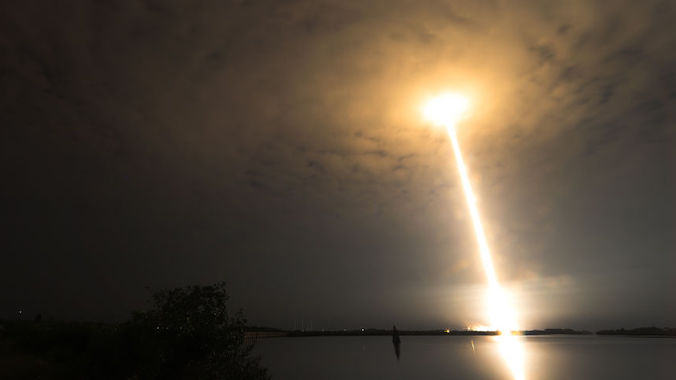Good luck…we can’t even get companies to stop poisoning drinking water for entire cities…you won’t stop Elon from doing whatever he wants when he and his buddies can just buy new laws.
Ozone is something where we’ve gotten big changes like that before.
That was before Fox “News” and the GOP made cooperation, or the pretense of cooperation, a mortal sin.
How about we wait until the science is actually in before kneejerking around? We have had the science equivalent of a shower thought, actual work and analysis needs to be done before jumping to conclusions.
How about we wait until the science is actually in before sending hundreds and thousands of satellites into LEO?
That’s an interesting idea to consider (if I understand you correctly in that you are stating that there should be a central research authority that regulates what companies are allowed to do). Though, I wonder if it’s still better to sue for damages after the fact and create regulations to cover the oversight. There’s also the issue of data — you can’t exactly study an issue before it exists. If you are instead inferring that a company should conduct this sort of safety research themselves, it creates a sort of prisoner’s dilemma: companies wouldn’t be to keen on sharing their research with others, and if they are forced to, a company wouldn’t want to be the one to waste the money on it for others to profit off of.
I’d also like to note that this sort of regulation has no business being the decision of a single country, but, instead, it should be the decision of a global government, as it is an issue that affects the whole planet. How such a global government should be structured, though, I am not yet certain. The UN doesn’t exactly cut it.
NOAA is doing this science and is alarmed, this isn’t just some shower thought
Using an extraordinarily sensitive instrument custom-built at NOAA in Boulder, Colorado, and mounted in the nose of a NASA WB-57 research aircraft**, scientists found aluminum and exotic metals embedded in about 10 percent of sulfuric acid particles, which comprise the large majority of particles in the stratosphere. They were also able to match the ratio of rare elements they measured to special alloys used in rockets and satellites, confirming their source as metal vaporized from spacecraft reentering Earth’s atmosphere.
There will be a lot of work to understand the implications of these novel metals in the stratosphere,” Murphy said
I don’t see anything in that article about them being “alarmed”.
So far all the scientists appear to be saying “heads up, we need to investigate this further”, not “stop launching, this is bad”. We should listen to the scientists.
if you read the linked pnas article at https://www.pnas.org/doi/10.1073/pnas.2313374120 while remaining scientifically dispassionate I very much get the impression they are trying to warn us about the trajectory we are currently on.
You are correct though, the article doesn’t say that they are alarmed I have inferred that from following the subject in general.
Let’s fire some shit in the atmosphere first and then let scientists figure it out when it’s too late anyway. Absolute boomer shit
Urm i think the rocket needs to wait instead of us
But it’s going to make him slightly richer! How could you be so selfish?
Omg imagine elon having 100billion dollars, that would be so lit fam
or bezos, or anyone else.
Especially fucking Bezos.
Natural Gas rockets? What a small step for man, massive step back for mankind.
Natural Gas rockets? What a small step for man, massive step back for mankind.
Why do you dislike methane as a fuel? Also, in case you were unaware, as a side note, SpaceX’s newest rocket, which is currently under active development, Starship and Super Heavy, uses methane as a fuel.
SpaceX’s newest rocket, which is currently under active development, Starship and Super Heavy, uses methane as a fuel.
Okay thanks, I like it EVEN LESS NOW. We have better rocket fuels which degrade into water vapors. Using Natural Gas rockets is the environmentally unfriendly option that make corporations more money.
We have better rocket fuels which degrade into water vapors.
Which fuels are those? Also why would one want their rocket fuel to degrade? I can see fuel storage issues with that. Furthermore, keep in mind that the reaction of CH4 and O2 (combustion) creates H2O (water) and CO2. The only fuel that I’m aware of that creates only water when it’s combusted in O2 is H2 (hydrogen).
An issue with hydrogen as a fuel, when compared with methane, is its mass — lower exhaust mass lowers the specific impulse.Cool, glad you could see the light.
What? You didn’t answer any of my questions, nor did you comment on any of my side notes.
Your questions were shit, mate. The important part is that natural gas rockets are a cost cutting measure that is harmful to us all.
Methane is CH4. When it burns, it turns into Carbon (NOT carbon dioxide) and Hydrogen.
Best be hoping Tesla collapses and Elon gets his with the SEC. When TSLA falls, he will lose his connections and no one will be willing to protect him, just another loser millionaire white guy and sometimes the government does go after them.
Elon will likely be fried at that point because he will have committed the worst crime in America: messing with rich people’s money.
Best be hoping Tesla collapses
Why?
SpaceX has been receptive to design changes to starlink in the past to minimize impact, like decreasing reflectivity and reflection angles for astronomers. They might be receptive to moving to different alloy for the body construction.
Magnesium comes to mind that would be light but expensive. Steel alloys might be cheap and heavy options for later when starship is operational. Would those have similar effects on ozone, or is it only the aluminum oxides? Carbon fiber also looks promising. It could be pretty cheap and light if you can keep it planar rather than custom formed. Someone had mentioned wood in a different thread, but I’m uncertain if that’d work because of off gassing.
Japan I think launched a wooden one, will see what they find out
This feels like a copypaste of the same comment from a similar thread a few days ago.
Yeah it is. My comment then too.
I find it funny that even the problems he “invents” are not new.
deleted by creator
Wow. I read that as ozone laser and was super confused.
I’ll write Elong to stop on Twatter.
Of all the valid reasons to hate elon for, this is not one of them. The emissions from the entire world’s satellite re-entries are basically nothing on an atmospheric scale.
The article cite a peer-reviewed scientific paper paper which indicate satellites reentry has a significant effect.
Have you published (or know of) a better research paper that show this is incorrect?
the population of reentering satellites in 2022 caused a 29.5% increase of aluminum in the atmosphere above the natural level.
[…]
As aluminum oxide nanoparticles may remain in the atmosphere for decades, they can cause significant ozone depletion.
There article is about a paper showing that there’s a significant increase in aluminum oxide in the atmosphere. The particulates from that are part of how the small amounts of chlorine in the atmosphere are able to destroy ozone.
And how do you know it’s magnitudes higher if you haven’t seen any studies taking it into consideration?
I question the potentially sensationalist title. Why specifically target “Elon Musk”? Would it not be more accurate to pin the responsibility on the entirety of SpaceX? I could certainly be mistaken, but I feel that the decisions made at SpaceX are not only Elon’s.
How much do you think (micro)metoerites bring in daily?
https://phys.org/news/2024-06-satellite-megaconstellations-jeopardize-recovery-ozone.html
When old satellites fall into Earth’s atmosphere and burn up, they leave behind tiny particles of aluminum oxide, which eat away at Earth’s protective ozone layer. A new study finds that these oxides have increased 8-fold between 2016 and 2022 and will continue to accumulate as the number of low-Earth-orbit satellites skyrockets.
Those micrometeors aren’t mostly aluminium.
Those micrometeors aren’t mostly aluminium.
Do you have a source for that? Perhaps I’m misunderstanding you, but I’ve found a number of sources that show that meteorites contain aluminum:
To be fair, I don’t think any of those claim that any meteorites are “mostly” aluminum. But is that a true requirement?
I did write “mostly” for a reason. Aluminium is used a lot in aerospace due to its low mass. There is a lot of matter falling from space naturally, but the composition is key to the effects that will have on the atmosphere. Satellites, spent stages etc. have different compositions to meteors.
Over 20 elements from reentry were detected and were present in ratios consistent with alloys used in spacecraft. The mass of lithium, aluminum, copper, and lead from the reentry of spacecraft was found to exceed the cosmic dust influx of those metals. About 10% of stratospheric sulfuric acid particles larger than 120 nm in diameter contain aluminum and other elements from spacecraft reentry. Planned increases in the number of low earth orbit satellites within the next few decades could cause up to half of stratospheric sulfuric acid particles to contain metals from reentry.
Have yet to see any of these ‘studies’ take into account and compare with natural meteorite effects, which are orders of magnitude larger than the satellites.
Are you just doing the thing where you cast doubt on journal articles because they feel wrong? You don’t think humans can affect the natural environment in such a way? This sounds oddly familiar and a bit ironic for this community…
Meteors aren’t made out of aluminum like satellites are btw. There will be more reasearch done and we will learn more. But for now, there’s a potential issue.
https://phys.org/news/2024-06-satellite-megaconstellations-jeopardize-recovery-ozone.amp
Meteors aren’t made out of aluminum
Aluminium is an element, it’s going to be present in meteors to the same extent it is on earth
Is that a thing? Meteors content matching Earths?
Meteors are leftovers of the same primordial stuff that made up earth, so a cross sample of them would largely share the same ratios as earth, minus the volatiles.
Though it looks like the community hive mind has made up its mind on this one
I did some very rough estimates and found that the amount of aluminum entering the Earth’s atmosphere each year is probably between 100 and 500 tons, which would be roughly comparable to the amount coming from these LEO comm sats like Starlink.
These are just super ballpark figures, but it’s in the same order of magnitude. More research is definitely necessary.
That’s not the comparison at all, the comparison is what the sattelites are made of (mostly aluminum) and what the meteors are made of (mostly other stuff, like earth).
deleted by creator
Niobium and hafnium do not occur as free elements in nature, but are refined from mineral ores. They are used in semiconductors and superalloys.
In addition to these two unusual elements, a significant number of particles contained copper, lithium and aluminum at concentrations far exceeding the abundance found in meteorics, or ‘space dust.’ “The combination of aluminum and copper, plus niobium and hafnium, which are used in heat-resistant, high-performance alloys, pointed us to the aerospace industry,’’ Murphy said.
they are finding elements that don’t even occur in nature, and elements that do occur but in proportions in the atmosphere that have grown significantly since we started burning up rockets.
Armchair scientists don’t seem to give actual scientists much credit.
they are finding elements that don’t even occur in nature
Neither of your referenced quotes claimed that the elemental makeup of the measured particulate was synthetic. If you are referring to “Niobium and hafnium do not occur as free elements in nature”, what this means is that the elements are not ever found on their own — they have only ever been found bonded to something else. Niobium makes up 0.0017% of Earth’s crust and Hafnium makes up 0.00033% [source (archive)].
Hm, while the presence of the elements in question in the atmosphere could be naturally occurring, what’s important to consider for this discussion is the rate of their increase. If there’s an increase in the problematic particulate in the atmosphere that correlates with an increase in the atmospheric burn up of artificial satellites with no related increase in the rate of meteors, then its likely that the artificial satellites were indeed the culprit.
They won’t, it’s just musk hate. I can’t stand the idiot either, but starlink has done more for rural and underserved homes than all the telcoms have in the last 30 years.
It may be true that Starlink is a great service, but that’s entirely irrelevant to the point of the article and any ozone destruction that the satellites cause.
Way more tons of meteorites burn up entering the atmosphere than the amount of shit starlink will even remotely produce.
https://phys.org/news/2024-06-satellite-megaconstellations-jeopardize-recovery-ozone.amp
The issue is that meteorites don’t have hardly any aluminum, which is the metal of concern here. We’re already seeing significant increases in the upper atmospheric concentration, and it’s projected to get a lot worse.
Meteorites do contain aluminum. The issue is with the concentration of aluminum in the atmosphere, as well as its rate of increase. If there’s an increase in the atmospheric burn up of artificial satellites accompanied by an increase in the problematic particulate in the atmosphere, then it’s certainly fair to consider that the two are correlated. This is especially so if there is no increase in the burn up of objects from any natural source — eg meteors.








